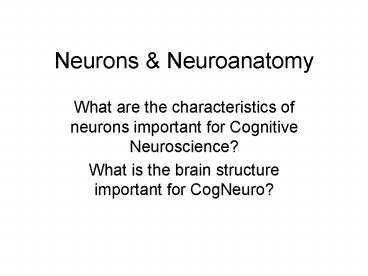Neurons - PowerPoint PPT Presentation
1 / 11
Title:
Neurons
Description:
Pseudounipolar - Bipolar cells where the dendrite and axon processes have merged. ... The signal a neuron generates down its axon is called an action potential. ... – PowerPoint PPT presentation
Number of Views:196
Avg rating:3.0/5.0
Title: Neurons
1
Neurons Neuroanatomy
- What are the characteristics of neurons important
for Cognitive Neuroscience? - What is the brain structure important for
CogNeuro?
2
(No Transcript)
3
Classes of neurons
- Unipolar - One process extends from body, which
can contain both dendrites and axon terminals - Bipolar - One axon and one dendrite process.
- Multipolar - Many dendrite processes.
- Pseudounipolar - Bipolar cells where the dendrite
and axon processes have merged. - Well be primarily interested in multipolar cells.
4
Neural membrane
- There are specialized structures in the neural
membrane that allow various elements to cross in
and out of the cell - Ion channels Proteins that cross the cell wall,
creating pores that allow ions (Na, K, Cl-) to
pass. - Specific to particular ions more K channels
- Nongated and gated
- Ion pumps Actively transport ions across the
membrane, creating an electric gradient across
the membrane (3 Na out 2 K in)
5
Cellular currents
- There are two types of electrical currents that
can pass through a neuron - Active currents are ones that are caused by
explicit chemical activity (opening and closing
of ion channels) ex - at the synapse and across
the surface of the axon - Passive currents are ones that simply pass
through the cytoplasm, typically as a response to
active currents ex - within the cell body as a
result of synaptic activity within the axon as a
result of action potentials.
6
Action Potential
- The signal a neuron generates down its axon is
called an action potential. - All action potentials are the same magnitude
(strength), so they are either on or off. - An action potential is only generated if the
depolarization of the cell membrane crosses a
threshold. - We determine how excited a neuron is by its
firing rate - how many action potentials per
second it generates.
7
Depolarization of the AP
- As opposed to the nongated ion channels discussed
so far, action potentials are driven by gated
channels that open in response to high voltage
levels (the threshold). - In particular, gated Na channels are opened by
membrane depolarization, which allows Na into
the cell. This causes further depolarization,
which opens more channels..
8
(No Transcript)
9
Repolarization of the AP
- Depolarization also causes voltage-gated K
channels to open, but slightly after the Na
channels. This drives K out of the cell,
reestablishing the resting potential of the cell
this is called repolarization. - Because of the delay, K flows out after Na
stops flowing in, so there is a brief period of
hyperpolarization
10
Neurotransmitter
- Neurons communicate by sending chemical messages
called neurotransmitters to other neurons. - These neurotransmitters travel from axon to
either the dendrite or the cell body across the
synapse. - Where a synapse is depends on what the connection
type is - Excitatory Axon to dendrite
- Inhibitory Axon to cell body
11
(No Transcript)































